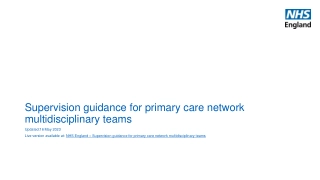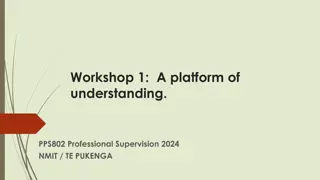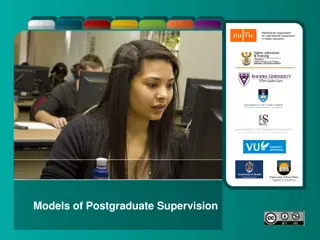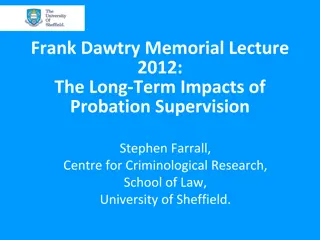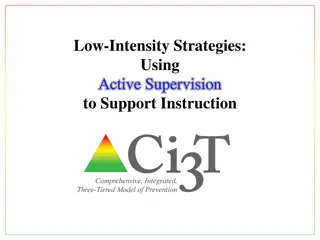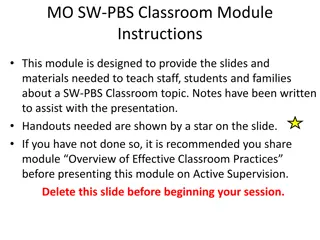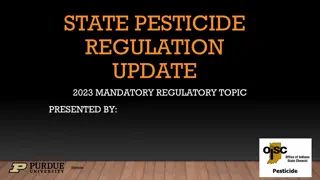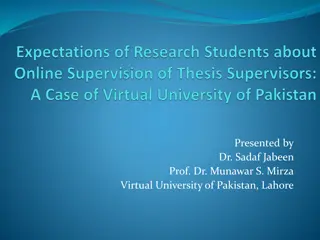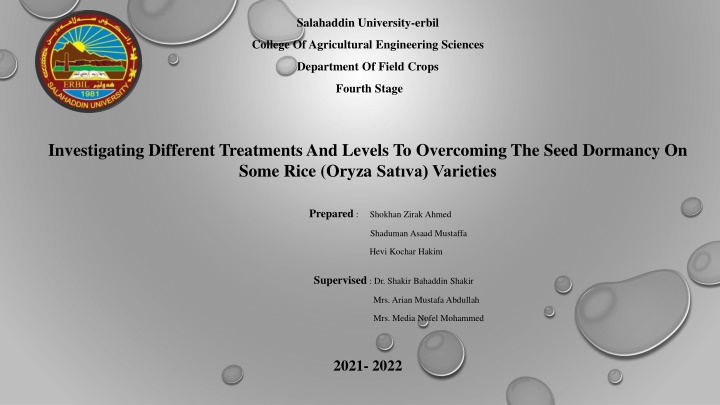
Investigating Methods to Overcome Seed Dormancy in Rice Varieties
Explore the challenges of seed dormancy in rice varieties and the methods used to overcome this natural adaptation. Learn about the importance of breaking dormancy before sowing to ensure successful germination and crop yield.
Download Presentation

Please find below an Image/Link to download the presentation.
The content on the website is provided AS IS for your information and personal use only. It may not be sold, licensed, or shared on other websites without obtaining consent from the author. If you encounter any issues during the download, it is possible that the publisher has removed the file from their server.
You are allowed to download the files provided on this website for personal or commercial use, subject to the condition that they are used lawfully. All files are the property of their respective owners.
The content on the website is provided AS IS for your information and personal use only. It may not be sold, licensed, or shared on other websites without obtaining consent from the author.
E N D
Presentation Transcript
Salahaddin University-erbil College Of Agricultural Engineering Sciences Department Of Field Crops Fourth Stage Investigating Different Treatments And Levels To Overcoming The Seed Dormancy On Some Rice (Oryza Sat va) Varieties Prepared : Shokhan Zirak Ahmed Shaduman Asaad Mustaffa Hevi Kochar Hakim Supervised : Dr. Shakir Bahaddin Shakir Mrs. Arian Mustafa Abdullah Mrs. Media Nofel Mohammed 2021- 2022
Introduction Objectives Materials And Methods Results Conclusion References
Introduction Seed Dormancy Is An Evolutionary Adaptation That Prevents Seeds From Germinating During Unsuitable Ecological Conditions That Would Typically Lead To A Low Probability Of Seedling Survival. Dormancy Of Rice (Oryza Sativa L.) Seed Is Imposed By Certain Physical And Chemical Factors Associated With Its Covering Structures, I.E. Hull And Pericarp. The Nature Of These Germination Blocks Their Mode Of Action; However, Processes Regulating The Release Of Dormancy Are Not Fully Understood.
The Traditional Method To Break The Seed Dormancy Is Soaking The Seed In Water. Dormancy May Be Broken As A Result Of The Exposure Of The Seed To A Single Factor At The Requisite Intensity For An Appropriate Period Of Time. Germination Then Follows The Breaking Of Dormancy. Alternatively, Dormancy Breaking May Require Or Be Accelerated By Exposure Of The Seed To Fluctuating Conditions, Such As Diurnal Changes Of Soil Temperature Or The Diurnal Cycle Of Light And Darkness.
At The Time Farmers Sowing Healthy Seeds With High Quality And High Germination Rates, The Germination Process For Some Or All Seeds Will Fail Due To Dormancy. This Leads To Loss And Reduction Of Yield; Therefore, It Is Significantly Important To Break The Dormancy Of Dormant Seeds Before Sowing To Overcome This Problem. Figure 1 Shows The Seed Germination Stages
Dormancy May Be Broken In Response To The Range Of Diurnal Fluctuations Occurring At A Particular Season Of The Year, Such As Spring, Or Dormancy Breaking May Result From The Seasonal Cycle Of Temperature, As For Example In The Succession Through Winter, Summer And Winter. In A More Complex Situation, Dormancy May Be Broken As A Result Of Exposure Of Seeds To An Appropriate Concentration Of Plant Growth Regulator (Pgr) Hormones Such As Indole Butyric Acid.
Objectives The Objectives In This Study Are Investigating (1) The Effects Of Plant Growth Regulators On Breaking Seed Dormancy. (2) Identify The Best Concentration Of Using PGR To Break The Seed Dormancy Figure 2 Stages Of Radical Growth Of Rice Seeds
Materials And Methods This Experiment Has Conducted In The Laboratory At The Agricultural Engineering Sciences College Salahaddin University/ Erbil In Mid-december 2021. The Seeds Of Two Kurdish Rice Varieties (Tahaluf And Kasnaditi) That Were Harvested Last Year Is Used To Break The Dormancy. Several Methods Of Overcoming Method Have Applied In This Experiment. Tow Treatments And Control With Three Replications For Each Have Been Used On Both Varieties As Follow: 1. Control: Untreated Seeds Were Placed In The Petri Dish Then Washed With Distil Water And Naoh Then Placed In The Germinator. 2.Soaking In Water: Seeds Were Put In Water For 24 Hours At Room Temperature Then Washed By NOH Placed In Petri Dishes And Placed In The Germinator.
3. Hormone Indole Butyric Acid IBA : This Hormone Is Used In Agriculture To Promote Root Initiation/Growth From Plant Cuttings. It Is Used With Three Different Concentration ( 100, 250 And 500 Ppm. The Seeds Were Soaked In Each Concentration For 24 Hours At Room Temperature. Then Washed With Naoh To Avoid Contamination, Seeds Have Been Put In Petri Dishes And Placed In The Germinator Chamber With 18-28 C (Night/ Day)
Everyday Data Were Recorded (Number Of Germinated Seeds And Speed Germination For Each Treatment. Seed Germination Speed For Both Varieties Were Calculated Depending On The Formula Below: Where, N ,N , N3, ,N Are The Number Of Germinated Seeds Observed At Time (Days Or Hours) T1, T2, T3, T After Sowing (Not Accumulated/Cumulative Number, But The Number Of Seeds That Germinated At The Specific Time) And K Is The Total Number Of Time Intervals.
Results In This Tetestst, We Wanted To Work On That Hormone On Rice To Know At What Level Its Dormancy Will Be Broken Because It Has Been Tested On Strawberry And Some Other Types Of Fruit Before And Had Effective Results. After The Seeds Were Placed In The Germinator, It Was Expected To Get A Good Result, But Rice Varieties That Were Used Was Newly Cultivated Kurdish Rice That Was Pure And Was At High Germination Rate Or Quality Perhaps, These Two Types Of Rice Had Never Entered The Dormancy Stage, When The Untreated Control Seeds Grew Two Days After The Hormones, Emphasises That The Seeds Were Not At Dormant Stage. The Hormone
Figure 4 Shows seed germination speed for both varieties Figure 3 Shows the interaction effects of (Treatments vs Varieties) on seed germination speed
IBA 100 Ppm Had Increased The Speed Of Germination And It Made The Standard Speed Of Germination Double. Of Both Varieties Followed By 250 And 500 Ppm. However, Speed Of Germination Of Water Treatment Was Similar To Control (Figure 3). Nevertheless, The Speed Germination Of The Two Varieties Were Different, V2 Were Germinated Faster (Figure 4). This Means Not Necessarily The Effect Of IBA Has Increased The Germination Speed, It Can Be Also Due To The Quality Of The Variety.
In The Figure The Hormone H100ppm Mean Has The Best Result In The Shortest Time In 4 Days. Then Followed By H250 Ppm And H500 Ppm , It Started To Germination In 6 Days. This Means That As Soon As The Rate Of Using The Hormone Is Lower, The Result Is Better. Both Control And Water Treatment The Seeds Started To Germinate After Hormones In 10 Days. Figure 5 The record of the last day of seed counting Figure 4 Shows the effects of Treatments on seed germination speed
Table (1) Analysis Of Variance (ANOVA) Of The Influence Of The Different Treatments On The Seed Germination
Conclusion the goal in this experiment was to help farmers improve planting, growth, and quality of production. often the seeds will not be destroyed if they stay for a long time, they will only go to a stage called dormancy which is a state of seeds rest. farmer may not know how to plant the seeds immediately in this situation, which reduces the quality and quality of the product. we wanted to find the best way to break the dormancy by using three methods including control, water and three different concentration of indole butyric acid iba.
REFERENCES Offord, C.A. And Meagher, P.F. (2009). Plant Germplasm Conservation In Australia: Strategies And Guidelines For Developing,managing And Utilising Ex Situ Collections. Canberra: Australian Network For Plant Conservation Inc. Ertekin, M. And Kirdar, E., 2010. Breaking Seed Dormancy Of Strawberry Tree (Arbutus Unedo). Int. J. Agr. Biol, 12(1), Pp.57-60.Baskin, C.C. And Baskin, J.M., 1998. Seeds: Ecology, Biogeography, And, Evolution Of Dormancy And Germination. Elsevier. Jayasuriya, K.G., Baskin, J.M. And Baskin, C.C., 2008. Dormancy, Germination Requirements And Storage Behaviour Of Seeds Of Convolvulaceae (Solanales) And Evolutionary Considerations. Seed Science Research, 18(4), Pp.223-237. Shiratsuchi, H., Ohdaira, Y., Yamaguchi, H. And Fukuda, A., 2017. Breaking The Dormancy Of Rice Seeds With Various Dormancy Levels Using Steam And High Temperature Treatments In A Steam Nursery Cabinet. Plant Production Science, 20(2), Pp.183-192.
Tilebeni, H.G., Yousefpour, H., Farhadi, R. And Golpayegani, A., 2012. Germination Behavior Of Rice (Oriza Sativa L.) Cultivars Seeds To Difference Temperatures. Advances In Environmental Biology, Pp.573-578. Shiratsuchi, H., Ohdaira, Y., Yamaguchi, H. And Fukuda, A., 2017. Breaking The Dormancy Of Rice Seeds With Various Dormancy Levels Using Steam And High Temperature Treatments In A Steam Nursery Cabinet. Plant Production Science, 20(2), Pp.183-192. Baskin, C.C., Milberg, P., Andersson, L. And Baskin, J.M., 2002. Non deep Simple Morphophysiological Dormancy In Seeds Of The Weedy Facultative Winter Annual Papaver Rhoeas. Weed Research, 42(3), Pp.194-202. Watanabe, K. And Sato, H., 1998. Effect Of Heat On Breaking Seed Dormancy And Its Varietal Differences In Rice [Oryza Sativa] To Germination, 1: Varietal Differences And Condition Of Temperature To Germination. Tohoku Agricultural Research (Japan).
Shu K, Liu Xd, Xie Q, He Zh (2016) Two Faces Of One Seed: Hormonal Regulation Of Dormancy And Germination. Mol Plant 9:34 45 Cai HW, Morishima H (2000) Genomic Regions Affecting Seed Shattering And Seed Dormancy In Rice. Theor Appl Genet 100:840 846 Baun, L.C. (1972) Biochemical Studies On Dormancyof The Rice Grain. MS Thesis, University Of The Philippines At Los Ba os. 64 Pp.Google Scholar Ellis, R.H., Hong, T.D.And Roberts, E.H. (1983) Procedures For The Safe Removal Of Dormancy From Rice Seed. Seed Science And Technology 11, 77 112.Google Scholar Offord, C.A. And Meagher, P.F. (2009). Plant Germplasm Conservation In Australia: Strategies And Guidelines For Developing,managing And Utilising Ex Situ Collections. Canberra: Australian Network For Plant Conservation Inc. Wardle, D.A., Ahmed, M. And Nicholson, K.S., 1991. Allelopathic Influence Of Nodding Thistle (Carduus Nutans L.) Seeds On Germination And Radicle Growth Of Pasture Plants. New Zealand Journal Of Agricultural Research, 34(2), Pp.185-191.
THANKS FOR YOUR ATTENTION

